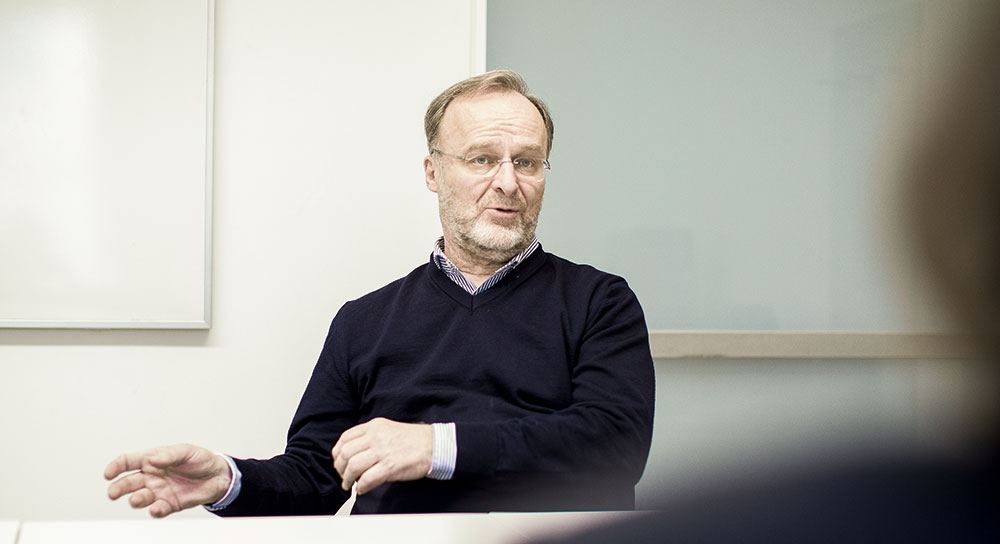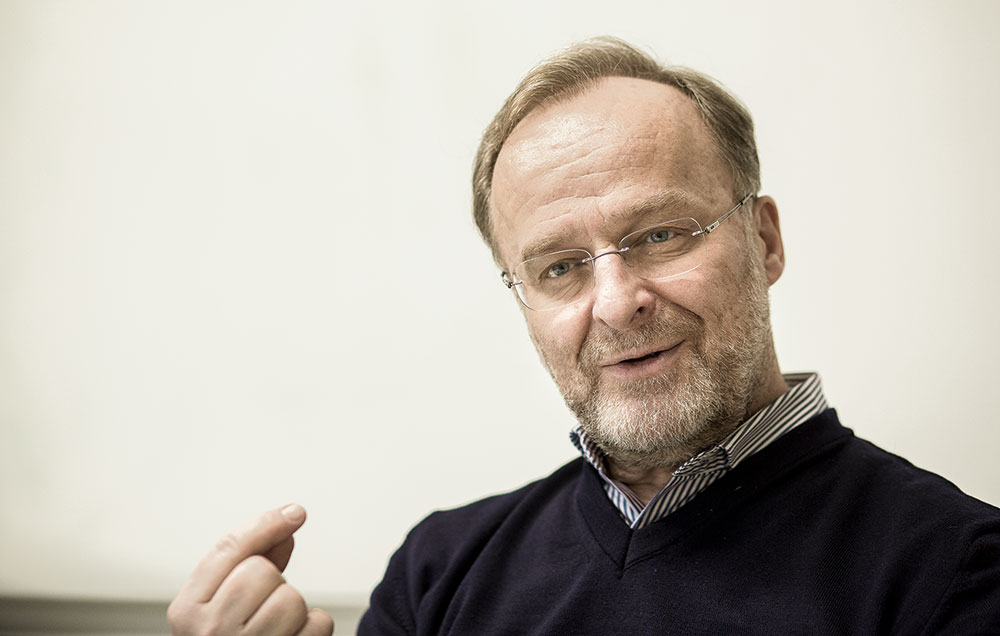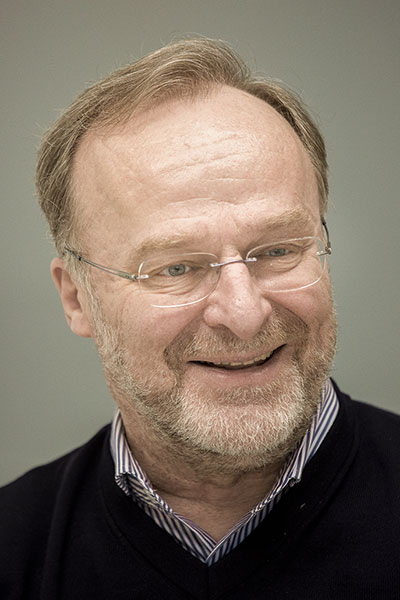A Conversation with Prof. Helmut Zehetner, in Charge of Orchestral Instruction at the mdw

How would you describe to an alien—or to someone who’s perhaps never been to a concert—just what an orchestra is?
Helmut Zehetner (HZ): The essence of an orchestra is its conveyance of both emotional and intellectual content using a comprehensive spectrum of sound. All of us were shaped by the sounds we heard in our mothers’ wombs, and we feel best when the sounds we hear today get us as close as possible to those experiences back then. So it’s probably the case that people originally tried to use their instruments creatively to add something to this quality, to make it more intense. And to this day, the result—as far as classical music goes, at least—has been the symphony orchestra.
You come from an ensemble that’s said to have very distinct characteristics as a collective. So just what kind of creature is an orchestra, really?
HZ: That’s a very hard question to answer, but it’s ultimately a miniature human society—maybe even comparable with a school class, which spends a certain period of life together working on a common task. A school class is a context where certain behavioural patterns arise, along with certain individuals’ desires to stand out. It’s similar in an orchestra—though the score and the individual parts do, of course, establish specific responsibilities. So in principle, an orchestra is a society that attempts to bring to life a work that was imagined by a composer who wrote it down using an imperfect system of notation. And because it has to be brought to life all over again every time, we constantly have to try and be as convincing and authentic as possible—which sometimes means going beyond simply being true to the score.
How, at an institution like the mdw, can these objectives be conveyed to students when many of them are (also) musical loners intent on developing their qualities as soloists first and foremost?
HZ: Once the various parts are learned, the main work pertains to how the individual groups play together—because the end result needs to be up to the level of perfection that present-day audiences expect. Playing in an orchestra is the most complex form of communication ever developed by human beings. Nowhere else do you have so many different statements being made simultaneously without the whole thing disintegrating into smaller groups—for which reason it’s crucial that all players know how their respective parts relate to the greater whole. So the most important point for me is to train people’s ears. These days, we’re very strongly conditioned to let visual stimuli dominate our perception, even though our ears are more versatile sensory organs than our eyes are. You can hear something that’s around the corner even though you can’t see it. But this is an ability that people don’t normally train. Every musician can learn to read a score relatively fast. But hearing a score in your head is much harder—and this is what has to be done in order to produce a truly intense sound and engage in intense communication as a group. This is the central point of what we do in orchestral instruction. And in doing so, we also convey how such work can be a great and hugely satisfying thing to engage in.

…especially when the Webern Symphonie Orchester gives one of its performances at the Musikverein…
HZ: Of course. We’ve always aimed for results that are absolutely superlative. And having the opportunity to play in one of the world’s most important concert halls with a truly great conductor while still in school is something very special, so my inner motivation here was to make it possible for students to experience this feeling. But our success in this also comes thanks to many factors falling into place at the right time. And since our concert is part of two series, one offered by the Musikverein and the other offered by Jeunesse, we always have a soldout hall and an enthusiastic audience.
You work throughout the academic year, which gives each year’s orchestra time to develop into a collective—after which the big podium stars show up for the final rehearsals. How does what you’ve prepared fare in combination with these conductors’ respective personal styles?
HZ: Ultimately, in terms of interpretation and the artistic statement being made, this has to be the guest conductor’s concert. Our job here at the mdw, in the preparing that we do in sectionals and group rehearsals, is to get the various pieces up to a first-class level. My colleagues and I do, of course, bring our own ideas to bear, here—but we also investigate how the conductor is likely to realise their interpretation, like in terms of tempi. We don’t want to get all too specific all too early, though. After all, we’re still a place of training, this is a course, and gathering experience in making the leap from one conductor’s ideas to another conductor’s entirely different ideas is part of the learning process. In actual practice, you end up calling on this ability quite often. I once had an extreme case with the Vienna Philharmonic where we recorded Così fan tutte with Nikolaus Harnoncourt during the day and performed it live that evening under Riccardo Muti—same players, but otherwise a total 180. And that’s unbelievably fascinating. Orchestral musicians have to go along with what’s called for—regardless of whether they approve of everything. This kind of flexibility is enormously important in everyday professional life.
How important is it to train musicians in the operatic genre, which you regularly do for the university’s own productions at Schlosstheater Schönbrunn?
HZ: Opera is a challenge that’s entirely different from an onstage concert. It’s the toughest—but also the best—school for orchestral musicians. That’s why it’s important to me that we do a production every season. In opera, the singers dominate… and there’s also the factor of spatial distance. Which is why here, as well, cultivation of the musicians’ ability to listen is crucial to how well the various levels mix. That can’t be done by a conductor alone; the musicians also have to contribute a lot from their own experiences. The sense of space that’s needed when sitting in the orchestra pit is something they simply have to learn, as is interaction with the singers. And those who obtain a post in an opera orchestra later on will be glad they’ve already learned to deal with this to some extent. One’s first few years at a repertory theatre with lots of performances and barely any rehearsals really are like jumping into cold water—so the more experienced one is with having to react fast, the better.

Helmut Zehetner
Born in Amstetten in 1955, Zehetner has played violin in the Orchestra of the Vienna State Opera since 1980—and since 1983, he’s been a member of the Vienna Philharmonic (where he now plays as principal second violinist); he also performs as a chamber musician and has conducted various international chamber orchestras. From 1997 to 2014, Zehetner has headed the string department at the International Orchestra Institute Attergau, and he’s held a full professorship in orchestral instruction at the mdw since 2008.
In April 2019, Lorenzo Viotti conducted the Webern Symphonie Orchester’s concert at the Musikverein. And at Schlosstheater Schönbrunn, the orchestra recently performed under Christoph U. Meier in Mozart’s Le Nozze di Figaro.

